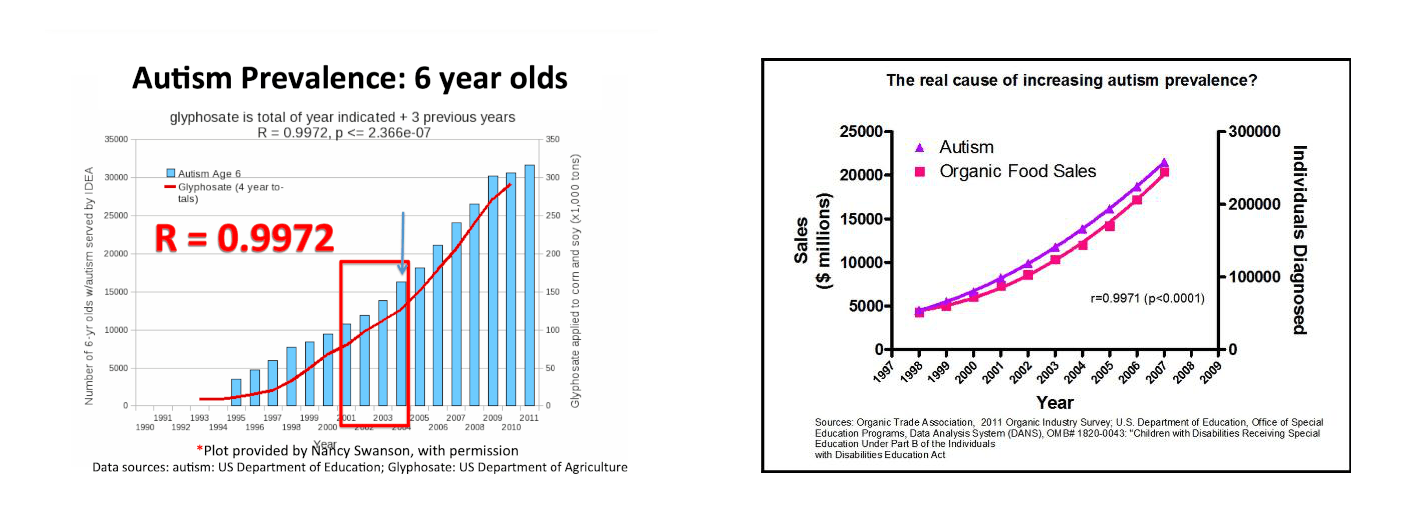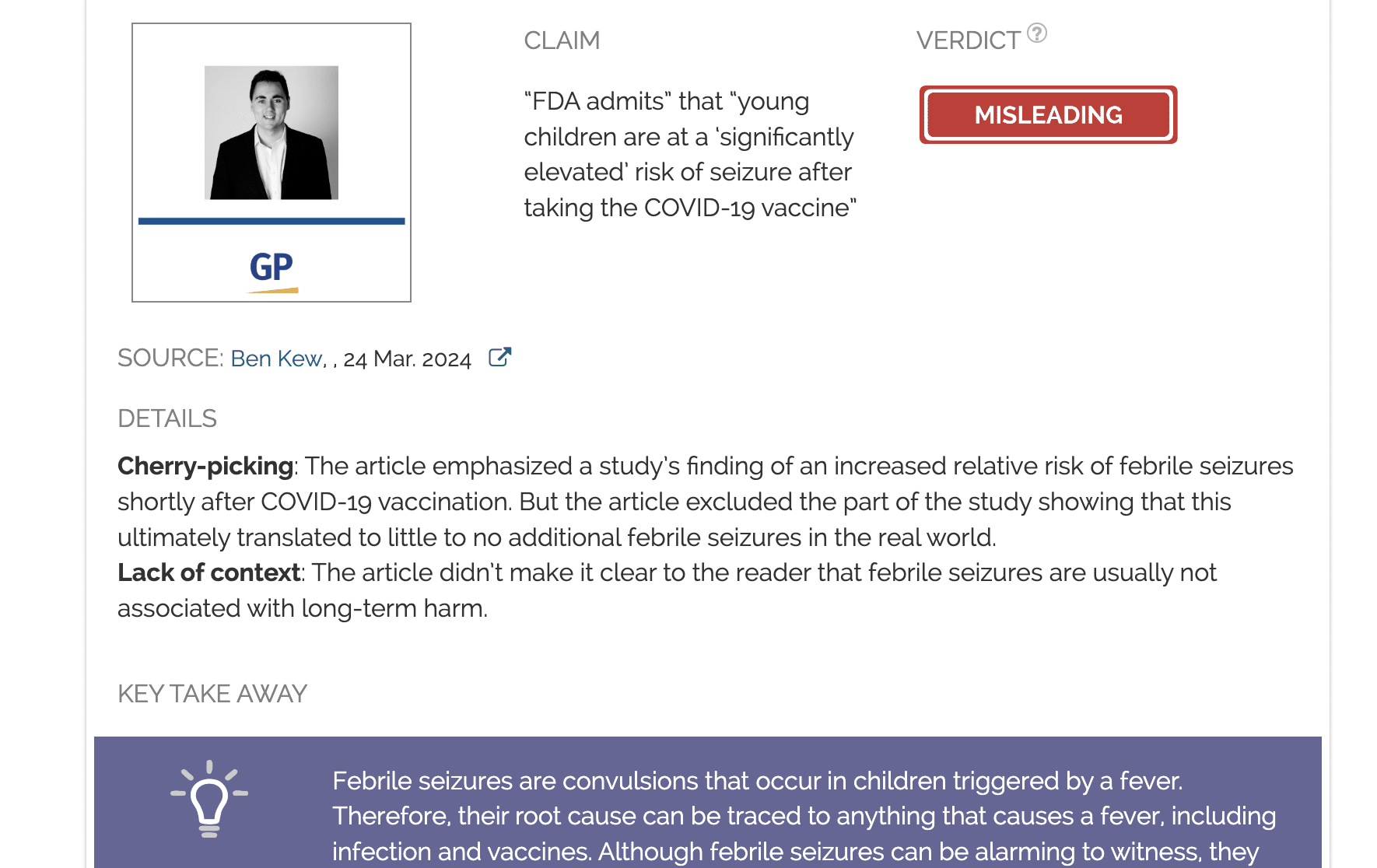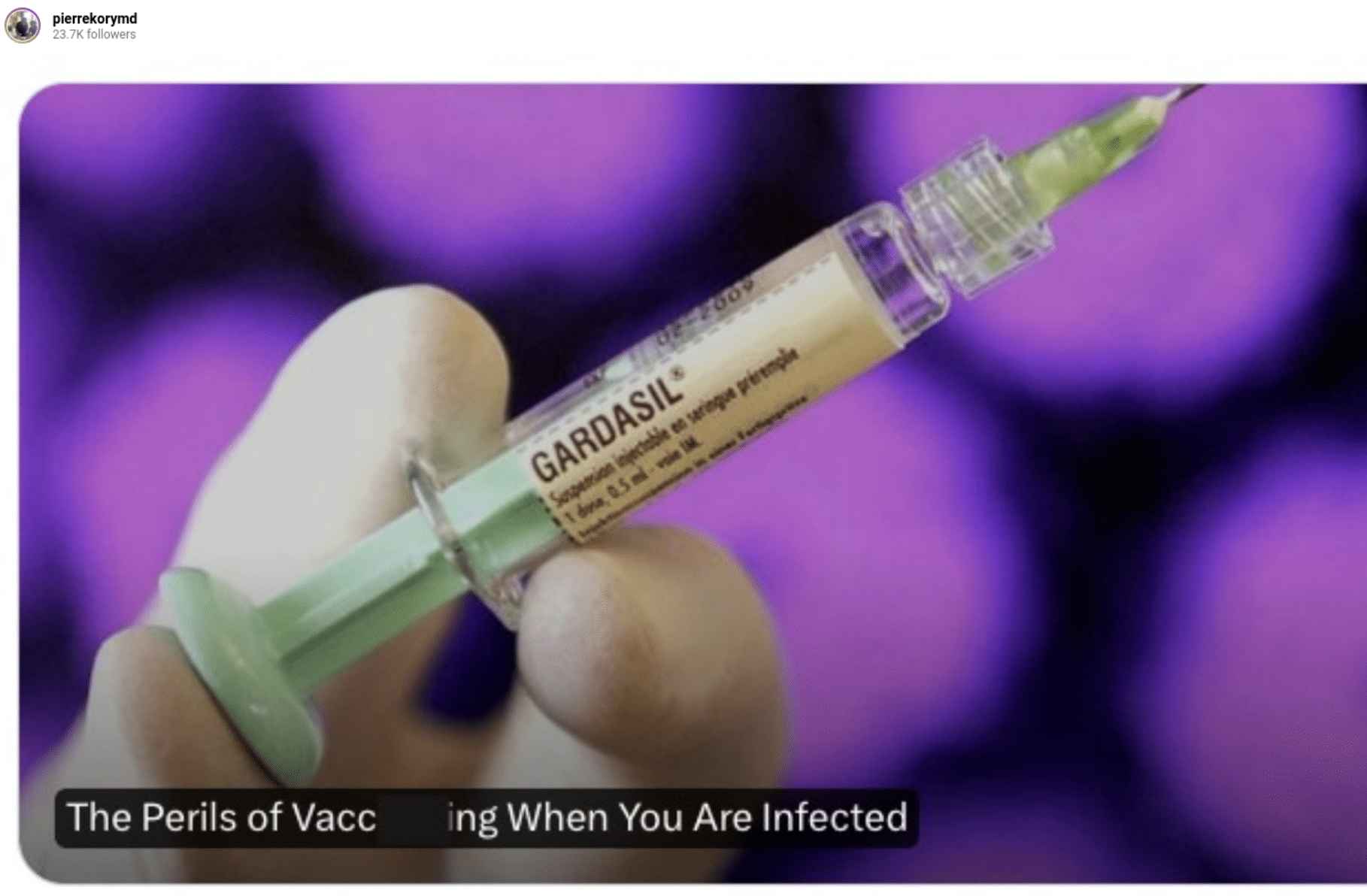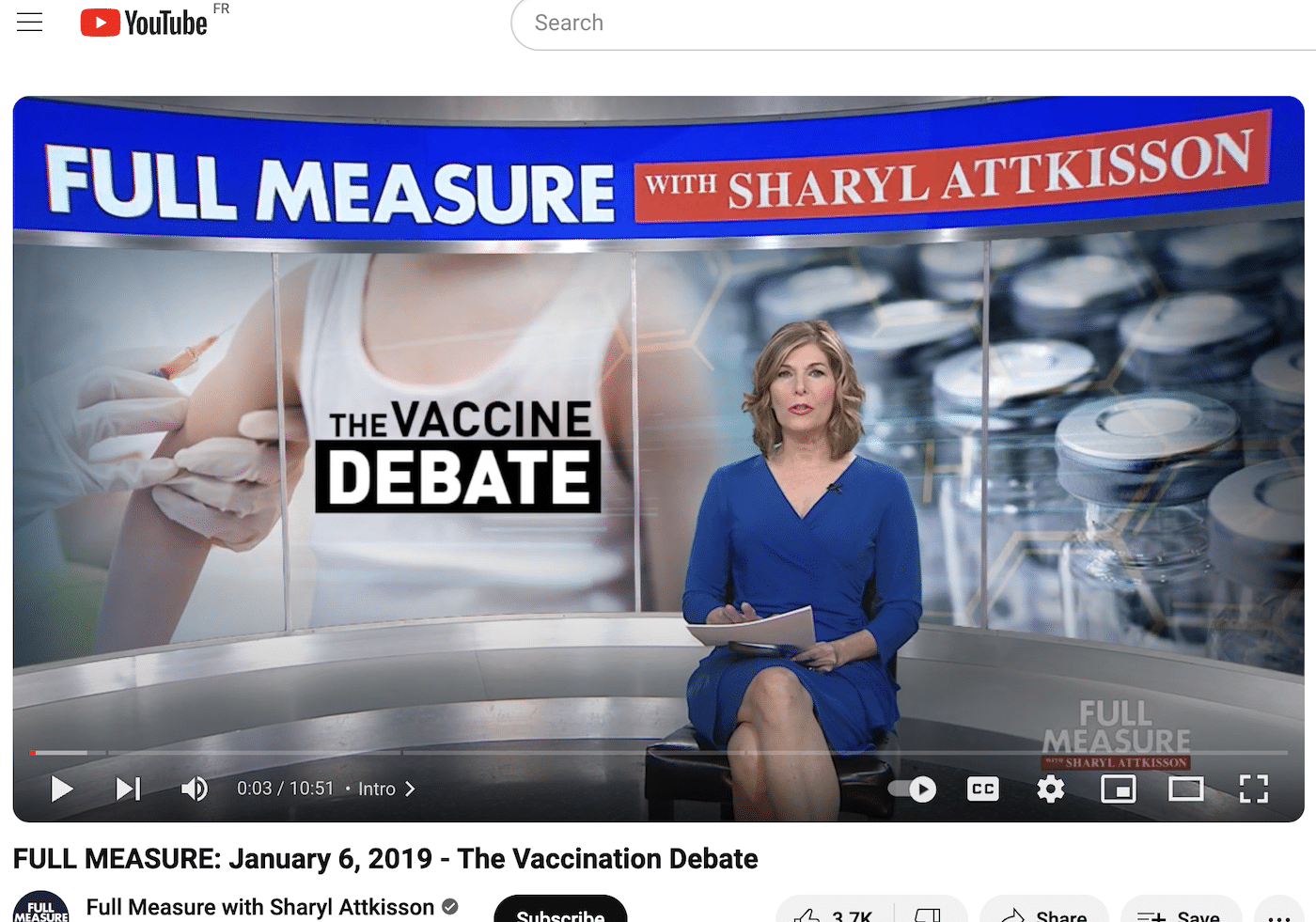- Health
Instagram reel rehashes old misinformation inaccurately linking autism with vaccines, glyphosate, and MTHFR mutations
Key takeaway
Autism spectrum disorder is a complex neurodevelopmental disorder commonly manifesting in difficulties with social interaction and communication, among other symptoms. Epidemiological studies of hundreds of thousands of children have found no association between childhood vaccination and autism. Variants of the MTHFR gene are common and claims that MTHFR mutations lead to an inability to “detox” from vaccines are false. Reliable scientific evidence about glyphosate’s association with autism is currently lacking, although more research in this area is needed to better understand the potential impact of glyphosate exposure.
Reviewed content

Verdict:
Claim:
Vaccines, MTHFR mutation, and glyphosate lead to autism in children with brain injury
Verdict detail
Incorrect: Multiple published studies have found no association between childhood vaccines and autism. Vaccines aren’t toxic; ingredients in vaccines are safe at the levels they are used.
Inadequate support: There’s little to no evidence at the moment indicating that glyphosate increases the likelihood of autism in children. No evidence is presented to support the speculation that a combination of vaccines, MTHFR mutation, and glyphosate increases the risk of autism in children.
Full Claim
“Birth injury —> autism ??? May seem like a stretch…but if a baby’s nervous system is injured in birth, and then you add to the mix: vaxxines, an MTHFR mutation, and environmental poisons like glyphosates…the connection seems more plausible, albeit indirect”; vaccines contain “toxic heavy metals like aluminum, but also polysorbate 80 [...] an emulsifying agent, that helps every drug that it’s added to cross the blood-brain barrier”
Review
In November 2023, obstetrician and gynecologist Nathan Riley, who has more than 23,000 followers on Instagram, posted an Instagram reel suggesting that vaccines, glyphosate, and mutations in the MTHFR gene contribute to the development of autism in children with brainneurologic injury. The reel’s caption stated “Asking questions is the thesis of science. Being unwilling to question your bias is antithetical to science”.
Riley’s speculation can be traced back to misinformation that attributes autism to childhood vaccines, the MTHFR gene, or glyphosate, that has been cropping up for years, as Health Feedback reviews and other science-related articles have documented. The assertion that he is “just asking questions” also presumes that there are grounds to suspect vaccines, MTHFR mutations, and glyphosate cause autism. However, most of these claims have already been investigated and discredited. We explain below.
Vaccines don’t cause autism, aren’t toxic
There are more than 20 published studies and reviews that found no association between childhood vaccines and autism[1-21], which Health Feedback documented in an earlier review.
We get a better understanding of Riley’s basis for this suggestion, when he claimed that “the many childhood vaccines […] include not just toxic heavy metals like aluminum, but also polysorbate 80, which is an emulsifying agent, that helps every drug that it’s added to cross the blood-brain barrier”.
With this context, we can thus see that his claim is no different from the age-old anti-vaccine talking point that vaccines contain toxins that damage the brain, leading to autism. Despite having been refuted numerous times, this still remains a favorite argument for those opposed to vaccination.
Some vaccines do contain aluminum in the form of aluminum salts. These act as adjuvants, which enhance our immune system’s response to vaccination. Experts told Health Feedback that vaccine ingredients are present at levels that are safe and aren’t associated with health problems.
Moreover, as the Vaccine Education Center (VEC) at the Children’s Hospital of Philadelphia (CHOP) explains, the amount of aluminum that infants receive from vaccines in the first six months of life is dwarfed by the amount they receive through their diet:
“The aluminum contained in vaccines is similar to that found in a liter (about 1 quart or 32 fluid ounces) of infant formula. While infants receive about 4.4 milligrams of aluminum in the first six months of life from vaccines, they receive more than that in their diet. Breast-fed infants ingest about 7 milligrams, formula-fed infants ingest about 38 milligrams, and infants who are fed soy formula ingest almost 117 milligrams of aluminum during the first six months of life.”
Polysorbate 80 is also another ingredient we’ve seen embroiled in health misinformation, albeit around vitamin K injections, which are given to newborns to prevent potentially fatal hemorrhages as a result of vitamin K deficiency.
Also called PS80 or Tween-80, polysorbate 80 is a fatty molecule used as an emulsifying agent. It helps ingredients that would otherwise separate from each other (like oil and water) to combine well in a mixture. As such, it is commonly used in industrially produced food like ice cream and sauces.
Polysorbate 80 is also present in some childhood vaccines. Like aluminum in vaccines, the amount of polysorbate 80 in vaccines is minuscule compared to the amount present in food. The VEC at CHOP explains:
“A typical serving of ice cream (1/2 cup) may contain about 170,000 micrograms of polysorbate 80. On the other hand, the amount of polysorbate 80 in each dose of these vaccines — 50 micrograms (HPV) and 160 micrograms (COVID-19) — is very small. Therefore, polysorbate 80 isn’t contained in vaccines at quantities that could possibly do harm.” [A microgram is one-millionth of a gram.]
Lena Claire van der List, a pediatrician at the University of California Davis, told AFP that polysorbate 80 isn’t associated with health issues.
“Parents should not be concerned about the concentration of polysorbate 80 in the vitamin K shot […] P80 is designated by the (US Food and Drug Administration) as generally recognized as safe […] While there are limited studies about P80, no adverse effects have been reported in infants who received vaccines with P80.”
No evidence that folic acid in the presence of MTHFR mutations increases the risk of autism
The reel also invoked the claim that the MTHFR gene is involved in the development of autism, particularly when folic acid is consumed.
This is highly similar to claims we’ve seen before about how the MTHFR gene affects the body’s ability to “detox” from vaccines and drugs, and thus could make certain children more vulnerable to vaccine adverse events. As we explained above, vaccines aren’t toxic and therefore don’t require a “detox”.
Some of these claims also assert that folic acid in foods could cause health problems for people with certain MTHFR gene mutations. Health Feedback discussed these claims at length in previous reviews, explaining that such claims are inaccurate and misleading.
MTHFR is the name of a gene that codes a protein involved in making certain amino acids and converting forms of folate
There are many variants of the MTHFR gene, and the most common variant is the C667T variant. In fact, there are more people with variants than people who don’t have them in the U.S. and evidence suggests this is also the case in Europe[22].
Some concern over MTHFR gene variants may be due to the finding that certain gene variants lead to decreased enzyme function. In cases where MTHFR enzyme function is severely reduced, it can lead to a condition called homocystinuria, a buildup of the amino acid homocysteine in the body. However, this condition is mainly associated with rare MTHFR gene variants, not with common variants.
The belief that the MTHFR gene is involved in the body’s response to vaccination can be traced back to a study published in the Journal of Infectious Diseases in 2008[23]. The study reported an association with a particular MTHFR variant with the risk of adverse events after smallpox vaccination, and was later cited to support medical exemptions from vaccination in children.
The authors of the study decried this practice in a letter to the editor, calling it “an unfortunate misuse” of their work and finding vaccine exemptions on the basis of MTHFR variants “not based on the precepts of replication of study findings and rigorous clinical testing”.
In their letter, the authors emphasized that their study only had to do with a smallpox vaccine candidate, not with childhood vaccines, stressing that “[t]here is no published evidence to suggest that the likelihood of an adverse reaction to one vaccine implies that an individual is expected to have a reaction to other unrelated vaccines”. They also cautioned that their study was very small and exploratory, and didn’t meet the standards for establishing “a robust genetic association”.
In brief, this study didn’t produce any data showing an association between childhood vaccines and autism. Its focus was on studying adverse events following a specific vaccination (smallpox vaccination), and not on autism.
Currently, there’s no reliable evidence that glyphosate increases the risk of autism
This claim received much attention on social media, after computer scientist Stephanie Seneff claimed in 2014 that “At today’s rate, by 2025, one in two children will be autistic” and attributed this to the use of glyphosate in farming. Since then, Seneff has gone on to blame the COVID-19 pandemic on glyphosate, a charge that has no basis in reality, as the McGill Office for Science and Society pointed out.
Glyphosate is the active ingredient in the weedkiller Roundup, originally produced by Monsanto, which has since been acquired by Bayer. Glyphosate is at the center of scientific controversy around its potential effects on health, as multiple lawsuits alleging that it can cause cancer have been filed, particularly after the International Agency for Research on Cancer (IARC) published an assessment in 2015 finding glyphosate to be “probably carcinogenic to humans (Group 2A)”.
For context, Group 2A carcinogens include working night shifts, drinking very hot beverages, and eating red meat.
The IARC’s assessment and the evidence linking glyphosate with cancer have come under scrutiny. Assessing this association is beyond the scope of this review, but we have linked to several articles which offer readers more information to contextualize this controversy. The IARC’s defense of its assessment can be found here. We will close by adding that regulatory agencies around the world—including the U.S. Environmental Protection Agency (EPA), Health Canada, and the European Food Safety Authority—dispute the IARC’s classification of glyphosate and have concluded that glyphosate, when used as directed, isn’t linked to an increase in cancer.
Coming back to Seneff’s claim, we can see from slides she created that the claim is based on a correlation of the number of autism cases diagnosed with the amount of glyphosate applied to corn and soy crops. As this Science-Based Medicine article pointed out, this naively equates correlation alone with causation, even though data also shows that the rise in autism diagnoses correlates with organic food sales (see Figure 1 below).

Figure 1 – Left: Seneff’s correlation of the number of children diagnosed with autism and the amount of glyphosate used on corn and soy in the U.S. Right: A correlation of autism diagnoses and the sale of organic food in the U.S.
If one applied the same logic that Seneff used, then one could just as well claim it is organic food that is causing the rise in autism. Yet both lines of reasoning would be incorrect, as correlation isn’t necessarily an indicator of causation.
Scientific studies have found that exposure to environmental pollutants, such as certain pesticides, is associated with a greater chance of having a child with autism[24,25]. Therefore, questioning whether glyphosate is associated with autism risk is important in ensuring its safe use.
At the moment, the studies around the question of whether glyphosate raises the likelihood of developing autism haven’t yet provided clear answers.
An epidemiological study in California’s Central Valley, published in the British Medical Journal in 2019, examined whether exposure to various pesticides was associated with autism cases[26]. This was made possible by examining data from California’s mandatory Pesticide Use Reporting program and residential addresses listed on birth certificates. Based on their analysis, the researchers reported an association between glyphosate exposure within 2,000 meters of a mother’s residence and the child’s autism diagnosis.
However, there is some degree of uncertainty around the associations reportedThat said,. This is reflected in many of the 95% confidence intervals for the odds ratios measuring an association between glyphosate and autism, which include one. Examples of this can be found in the study’s Tables 2 and 4. The 95% confidence interval is the range of values in which there is a 95% probability of finding the true odds ratio. An odds ratio above or below one indicates an association, but an odds ratio of one indicates no association. Thus, a 95% confidence interval that includes one means that there could also be no association between the two.
The authors acknowledged some limitations in their studies. For example, they weren’t able to account for pesticide exposure through other routes, like diet or occupation, hence determining mothers’ total exposure to pesticides wasn’t possible. They were also unable to account for different levels of exposure, with exposure defined only as either ever exposed or never.
Another caveat of the study is that the senior author, Beate Ritz, acted as an expert witness “in a lawsuit for the plaintiffs against Monsanto in non-Hodgkins lymphoma litigation concerning glyphosate”. This wasn’t disclosed when the study was first published in March 2019 and was later added in a correction in June 2019.
The authors concluded by stating that “from a public health and preventive medicine perspective, our findings support the need to avoid prenatal and infant exposure to pesticides to protect early brain development”, calling for further studies to better understand how autism develops.
Another study was published in 2020 in the Proceedings of the National Academies of Science, titled “Maternal glyphosate exposure causes autism-like behaviors in offspring through increased expression of soluble epoxide hydrolase”[27]. Curiously, the authors invoked Seneff’s problematic correlation, discussed above, as evidence for a possible association between glyphosate and autism (“a positive correlation was reported between the rise of glyphosate usage on corn and soy crops in the United States over the years 1995 to 2010 and the increase in ASD rates over the same period as reported in the US public school system”).
In the study, pregnant mice were fed water or water containing various amounts of glyphosate. The offspring of mice given 0.039% glyphosate showed no behavioral abnormalities, but the offspring of mice given 0.098% glyphosate exposure did show social interaction deficits. However, the researchers warned that “The glyphosate exposures used here exceed any reasonable dietary, environmental, or occupational exposure”, indicating a lack of direct relevance in humans.
The EPA states that “After evaluating numerous studies from a variety of sources, the Agency found no indication that children are more sensitive to glyphosate from in utero or post-natal exposure. As part of the human health risk assessment, the Agency evaluated all populations, including infants, children and women of child-bearing age, and found no risks of concern from ingesting food with glyphosate residues.”
Health Canada states that risk from glyphosate in food and water, as well as non-occupational exposure, is “not of concern”. The EFSA’s risk assessment found “no critical areas of concern” regarding glyphosate’s impact on health.
In summary, there’s currently little to no reliable evidence indicating that glyphosate increases the risk of autism in children. Further studies looking into this question is important and necessary for improving our understanding of glyphosate’s safety. For the moment, minimizing prenatal and infant exposure to glyphosate and other pesticides would be a prudent approach towards reducing any potential health impacts associated with such exposure.
The causes of autism and possible reasons for the rise in autism diagnoses
Autism spectrum disorder is a complex developmental disorder that can present as a combination of various symptoms, of varying severity. Some on the spectrum can function in daily life independently; others require substantial care for life.
Research is underway to understand the condition. Scientists have identified various genetic and environmental factors associated with autism. These include prenatal exposure to air pollution and certain pesticides, as well as birth difficulties that lead to periods of oxygen deprivation in the baby’s brain.
The U.S. National Institute of Environmental Health Sciences states that environmental factors alone “are unlikely to cause autism. Rather, they appear to increase a child’s risk for developing autism when combined with genetic factors.”
There has indeed been a rise in the number of autism diagnoses compared to the past. This has been exploited by some to spread health misinformation, with false claims linking the rise in autism diagnoses to an increase in vaccines in the childhood vaccination schedule. As we established earlier in this review: vaccines don’t cause autism. Health Feedback debunked such claims here.
Currently, the evidence suggests that a significant contributor to the rise in autism diagnoses is an evolution in the diagnostic criteria for autism over time. These changes were intended to account for children who showed ASD symptoms later, as well as subtler features of ASD that weren’t considered before.
In the U.S., the Diagnostic and Statistical Manual of Mental Disorders (DSM) serves as a guide for diagnosing mental disorders. Autism was first introduced in the third version (DSM-III) in 1980. A revised version of DSM-III in 1987 expanded the definition of autism. It also removed the requirement for the diagnosis to occur before the child’s thirtieth month. As a result, older autistic children who would have been excluded with the earlier criteria could now be diagnosed.
In 1994, the fourth version, DSM-IV, further broadened the definition of autism and introduced other variants, like Asperger’s syndrome.
The DSM-V, released in 2013, changed the definition of autism once again, pooling together categories that were previously distinct under the broader notion of autism spectrum disorder (ASD).
Therefore, the definition of autism grew over the years to account for the diverse ways in which the disorder manifests itself in people. Because the definition is now broader, more people may be diagnosed as having autism now than 40 years ago. In keeping with this, some scientific studies indicated that the changes in diagnostic guidelines are responsible for a part of the increase in autism prevalence[28,29].
Additionally, data show that the rise in autism diagnoses was accompanied by a decrease in diagnoses of intellectual disability[30]. This suggests that people who would have been diagnosed as intellectually disabled in the past are now more accurately diagnosed as having autism, thanks to our improved understanding of neurodevelopmental disorders.
Conclusion
Riley’s speculation that a combination of vaccines, MTHFR mutations, and glyphosate can lead to autism can ultimately be traced back to old misinformation around the causes of autism. The claim that vaccines contain toxic ingredients is false, and there have already been numerous studies looking to see if an association between childhood vaccines and autism exists. Large-scale reliable studies have found no such association. There’s also no evidence that MTHFR mutations affect a person’s ability to process folate or their response to vaccines. Evidence regarding a potential link between glyphosate and autism is scarce at the moment, although the few studies available at the moment are insufficient to support claims that glyphosate contributes to autism risk.
REFERENCES
- 1 – Madsen et al. (2002) A Population-Based Study of Measles, Mumps, and Rubella Vaccination and Autism. New England Journal of Medicine.
- 2 – Institute of Medicine. (2013). Adverse Effects of Vaccines: Evidence and Causality. Retrieved from https://doi.org/10.17226/13164
- 3 – Institute of Medicine. (2004). Immunization Safety Review: Vaccines and Autism. Retrieved from https://doi.org/10.17226/10997
- 4 – Institute of Medicine. (2013). Childhood Immunization Schedule and Safety: Stakeholder Concerns, Scientific Evidence, and Future Studies. Retrieved from https://doi.org/10.17226/13563
- 5 – Fombonne et al. (2006). Pervasive developmental disorders in Montreal, Quebec, Canada: prevalence and links with immunizations. Pediatrics.
- 6 – Taylor et al. (2014). Vaccines are not associated with autism: an evidence-based meta-analysis of case-control and cohort studies. Vaccine.
- 7 – Ball et al. (2001) An assessment of thimerosal use in childhood vaccines. Pediatrics.
- 8 – Hviid et al. (2003) Association Between Thimerosal-Containing Vaccine and Autism. JAMA.
- 9 – Madsen et al. (2003) Thimerosal and the occurrence of autism: negative ecological evidence from Danish population-based data. Pediatrics.
- 10 – Stehr-Green et al. (2003) Autism and thimerosal-containing vaccines: lack of consistent evidence for an association. American Journal of Preventive Medicine.
- 11 – Verstraeten et al. (2003) Safety of thimerosal-containing vaccines: a two-phased study of computerized health maintenance organization databases. Pediatrics.
- 12 – Andrews et al. (2004). Thimerosal exposure in infants and developmental disorders: a retrospective cohort study in the United Kingdom does not support a causal association. Pediatrics.
- 13 – Thompson et al. (2007) Early Thimerosal Exposure and Neuropsychological Outcomes at 7 to 10 Years. New England Journal of Medicine.
- 14 – McMahon et al. (2008) Inactivated influenza vaccine (IIV) in children <2 years of age: examination of selected adverse events reported to the Vaccine Adverse Event Reporting System (VAERS) after thimerosal-free or thimerosal-containing vaccine. Vaccine.
- 15 – Schechter and Grether. (2008) Continuing increases in autism reported to California’s developmental services system: mercury in retrograde. Archives of General Psychiatry.
- 16 – DeStefano F. (2009) Thimerosal-containing vaccines: evidence versus public apprehension. Expert Opinion on Drug Safety.
- 17 – Tozzi et al. (2009) Neuropsychological performance 10 years after immunization in infancy with thimerosal-containing vaccines. Pediatrics.
- 18 – Price et al. (2010) Prenatal and Infant Exposure to Thimerosal From Vaccines and Immunoglobulins and Risk of Autism. Pediatrics.
- 19 – Barile et al. (2012) Thimerosal exposure in early life and neuropsychological outcomes 7-10 years later. Journal of Pediatric Psychology.
- 20 – DeStefano et al. (2013). Increasing Exposure to Antibody-Stimulating Proteins and Polysaccharides in Vaccines Is Not Associated with Risk of Autism. Journal of Pediatrics.
- 21 – Uno et al. (2012). The combined measles, mumps, and rubella vaccines and the total number of vaccines are not associated with development of autism spectrum disorder: the first case-control study in Asia. Vaccine.
- 22 – Wilcken et al. (2003) Geographical and ethnic variation of the 677C>T allele of 5,10 methylenetetrahydrofolate reductase (MTHFR): findings from over 7000 newborns from 16 areas world wide. Journal of Medical Genetics.
- 23 – Reif et al. (2008) Genetic Basis for Adverse Events after Smallpox Vaccination. Journal of Infectious Diseases.
- 24 – Roberts et al. (2018) Children’s low-level pesticide exposure and associations with autism and ADHD: a review. Pediatric Research.
- 25 – Roberts et al. (2007) Maternal Residence Near Agricultural Pesticide Applications and Autism Spectrum Disorders among Children in the California Central Valley. Environmental Health Perspectives.
- 26 – Von Orenstein et al. (2019) Prenatal and infant exposure to ambient pesticides and autism spectrum disorder in children: population based case-control study. BMJ.
- 27 – Pu et al. (2020) Maternal glyphosate exposure causes autism-like behaviors in offspring through increased expression of soluble epoxide hydrolase. PNAS.
- 28 – King and Bearman (2009) Diagnostic change and the increased prevalence of autism. International Journal of Epidemiology.
- 29 – Hansen et al. (2015) Explaining the Increase in the Prevalence of Autism Spectrum Disorders.The Proportion Attributable to Changes in Reporting Practices. JAMA Pediatrics.
- 30 – Thurm et al. (2019) State of the Field: Differentiating Intellectual Disability From Autism Spectrum Disorder. Frontiers in Psychiatry.



